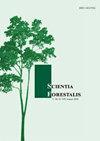Estrutura diamétrica e distribuição espacial de Dipteryx odorata (Aubl.) Willd. no oeste do estado do Pará, Brasil
IF 0.4
4区 农林科学
Q4 FORESTRY
引用次数: 0
Abstract
espacial, distribuição diamétrica, cumaru, Amazônia. Abstract The objective of this study was to evaluate the diametric structure and spatial distribution of Dipteryx odorata (Aubl.) Willd. (cumaru), in western Pará State, Brazil. The study was carried out in nine Work Units of 100 ha each, inserted in the Annual Production Area nº 8. The studied areas belong to the Tapajós National Forest Mixed Cooperative, municipality of Belterra. We collected the data through a 100% inventory, with mapping of all individuals with a diameter at 1.30 m above the ground (DAP) equal to or greater than 20 cm. The diametric structure was obtained through multivariate analysis. From this structure, we tested five probabilistic density functions (Weibull-3P, Gamma, Normal, Lognormal, and Exponential). The adjustment was assessed using the Kolmogorov-Smirnov histograms. The spatial distribution was obtained using Ripley's K function. The species had a diametric distribution tending to be normal for individuals with DAP ≥ 20 cm. This suggests problems of regeneration, probably caused by the boom in the collection of cumaru seed in the 1940s; low number of adults with high regenerative capacity and extremely low recruitment percentage. The spatial distribution of cumaru is predominantly random - probably due to the species' life cycle: as the individuals grow, the distribution becomes more random. The cumaru boom is another hypothesis that supports randomness. Seed collection may have affected the emergence of new individuals that would be responsible for the expected aggregation for the species.飞机双翼龙的直径结构和空间分布红凤。在巴西para州的西部
特别的,分布的, - - - - - - - - - - - - - - - - - - - - - - - - - -摘要:本研究的目的是评价双翅鸟(Dipteryx odorata, Aubl.)的直径结构和空间分布。Willd。(cumaru),巴西帕尔州西部。这项研究是在9个工作单位进行的,每个工作单位100公顷,插入第8年度生产区。研究区域属于Tapajós国家森林混合合作社,贝尔特拉市。我们通过100%的调查收集数据,并绘制了所有离地1.30 m (DAP)直径等于或大于20 cm的个体。通过多变量分析得到了直径结构。从这个结构中,我们测试了五个概率密度函数(Weibull-3P、Gamma、Normal、Lognormal和Exponential)。使用Kolmogorov-Smirnov直方图评估调整。利用Ripley’s K函数得到空间分布。当DAP≥20 cm时,种群的直径分布趋于正态分布。这表明了再生的问题,可能是由20世纪40年代红豆种子收集热潮引起的;再生能力强的成虫数量少,再生率极低。cumaru的空间分布主要是随机的——可能是由于物种的生命周期:随着个体的生长,分布变得更加随机。丘马鲁繁荣是另一个支持随机性的假设。种子收集可能影响了新个体的出现,而新个体的出现将导致物种的预期聚集。
本文章由计算机程序翻译,如有差异,请以英文原文为准。
求助全文
约1分钟内获得全文
求助全文
来源期刊

Scientia Forestalis
Agricultural and Biological Sciences-Forestry
CiteScore
1.00
自引率
0.00%
发文量
39
期刊介绍:
Scientia Forestalis is a scientific publication of the IPEF – Institute of Forest Research and Studies, founded in 1968, as a nonprofit institution, in agreement with the LCF – Department of Forest Sciences of the ESALQ – Luiz de Queiroz College of Agriculture of the USP – São Paulo University. Scientia Forestalis, affiliated to the ABEC – Brazilian Association of Scientific Publishers, publishes four issues per year of original papers related to the several fields of the Forest Sciences.
The Editorial Board is composed by the Editor, the Scientific Editors (evaluating the manuscript), and the Associated Editors (helping on the decision of acceptation or not of the manuscript, analyzed by the Peer-Reviewers.
 求助内容:
求助内容: 应助结果提醒方式:
应助结果提醒方式:


